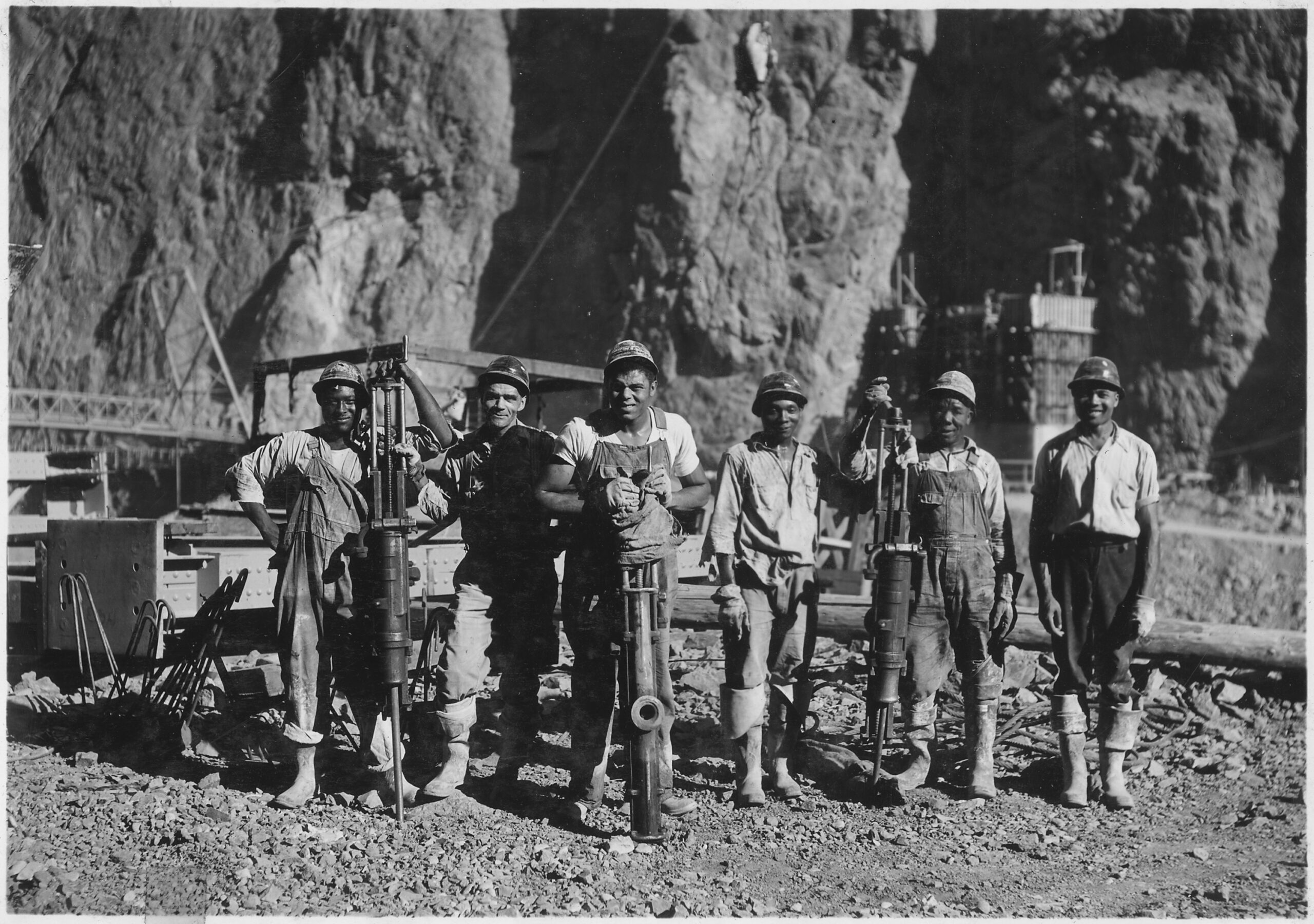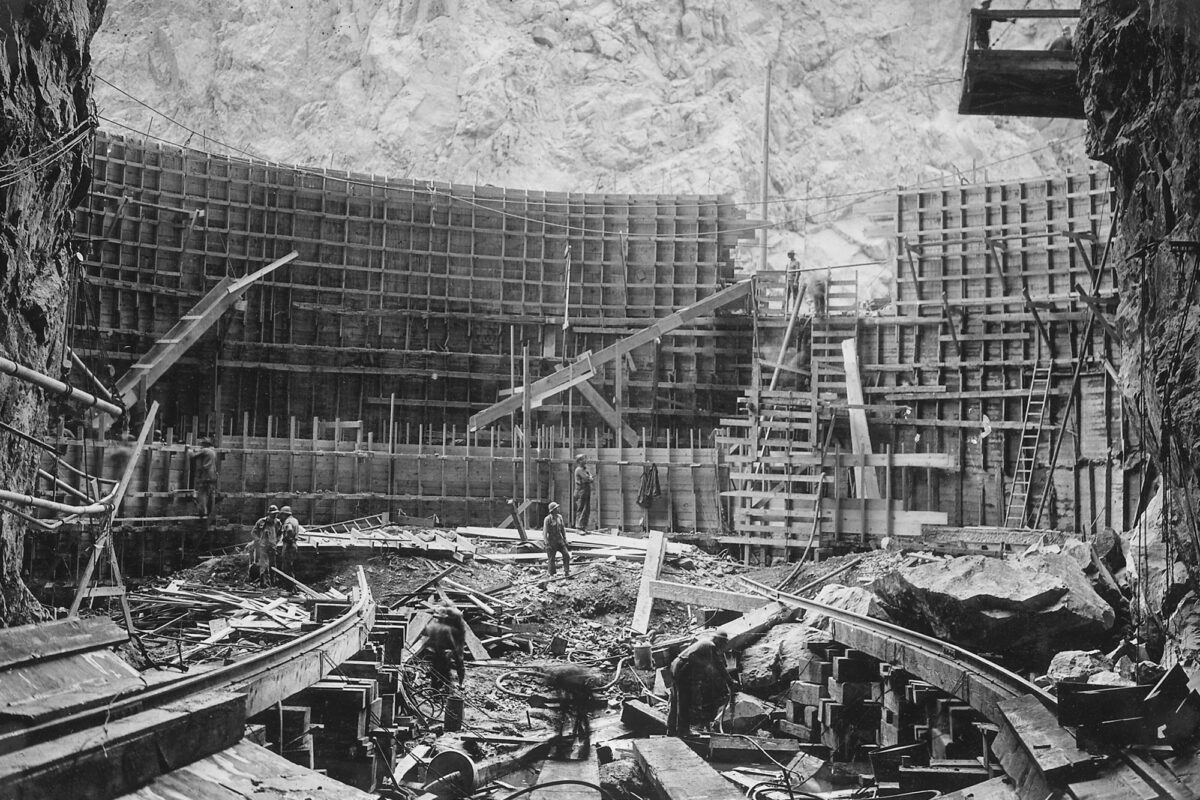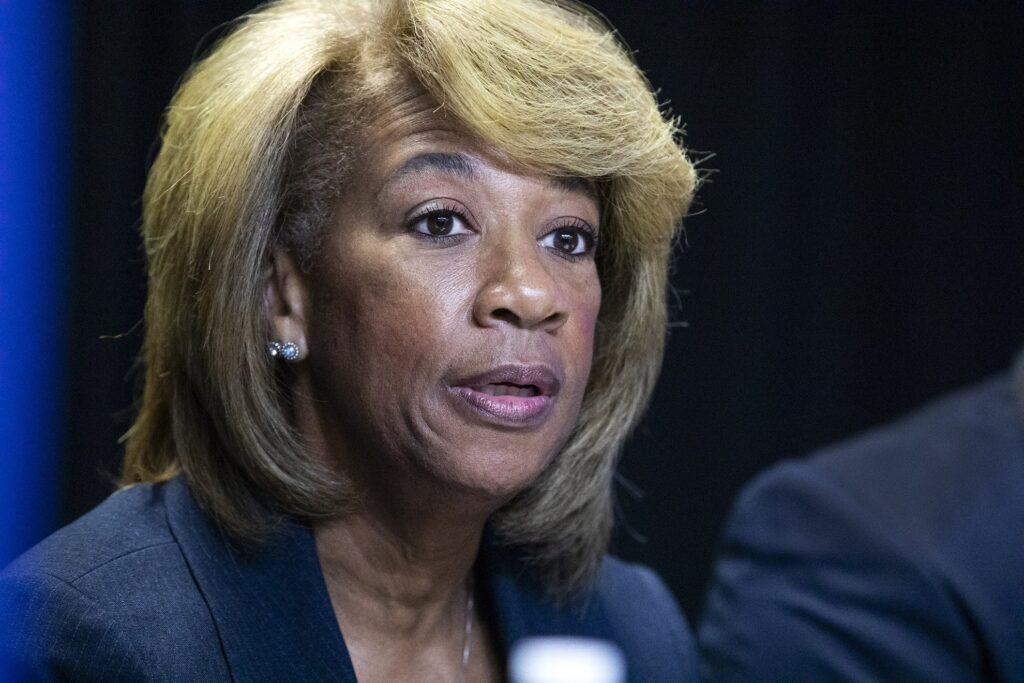How Hoover Dam hiring discrimination set back growth of Nevada’s Black community

Nearly a century ago, a towering wall of concrete and steel slowly filled Nevada’s Black Canyon. Behind it pooled millions of gallons of water, stopped in their downstream flow by the newly constructed Hoover Dam. A tremendous feat of human engineering, the dam reshaped not only the canyon but the face of the American West.
It “tamed” the Colorado River, providing water to land that explorer and former director of the United States Geological Survey John Wesley Powell had declared not suitable for irrigation. With a regular supply of water now available, Western cities and agricultural areas quickly grew.
Built during the Great Depression, it was the tallest dam in the world when completed and was briefly the world’s largest hydroelectric plant. In 1935, upon the completion of the dam two years ahead of schedule, then-President Franklin Roosevelt “dedicated Boulder Dam to the progress of the nation.”
Its construction represented strength, hope and resiliency for Americans during the largest economic downturn the nation had seen.
That is, for white Americans.
Although the dam provided good-paying jobs to white workers constructing the engineering feat of a lifetime, Black Americans looking for work were almost universally bypassed by Six Companies, the contractor overseeing the dam’s construction. More than 21,000 men worked on the dam between 1931 and 1936. Fewer than 50 were Black.
The refusal by Six Companies to hire Black workers hindered Las Vegas’ Black population from growing in the 1930s, according to historian and chair of the Las Vegas City Historic Preservation Commission Bob Stoldal.
“To me, there is no doubt, zero doubt, that the actions of Six Companies in building Boulder/Hoover Dam curtailed the growth of the Black population in Las Vegas,” Stoldal said during Black History Month.
The racism extended beyond who was and wasn’t hired to work at the dam. The few Black Americans hired were forbidden from living in Boulder City, the town built near the dam to house its workers.
“These were white jobs by a white American government that built a city called Boulder City to build the dam, and Blacks were not allowed to live there,” said Claytee White, director of UNLV’s Oral History Research Center. “This is the story of America.”
As Las Vegas later grew into a tourism-driven town, Black Nevadans still faced rampant discrimination, with some even referring to Nevada as the “Mississippi of the West.”
Some Southern Nevada Black leaders, such as White and North Las Vegas Mayor Pamela Goynes-Brown, see signs of progress and hope for the future. Goynes-Brown is the first Black mayor in the state’s history. The state’s attorney general, Aaron Ford, is the first Black American to hold a statewide constitutional office in Nevada.
But progress is slow, coming six decades after the nation signed the Civil Rights Act and nearly 100 years after Black workers with hopes of working on the Hoover Dam were purposefully excluded for rights as basic as being able to work and find housing.
“We will always be working toward equality,” White said.

‘The jobs are going to go to white men first’
In the early 20th century, Las Vegas was a small railroad town, a stopover point between Los Angeles and Salt Lake City with just 5,000 residents. Instead of towering casinos, thick, shady trees dotted Fremont Street. Mining towns such as Goldfield had larger populations.
Still, the Las Vegas area boasted the largest Black population in the state — around 2 percent of Clark County’s 8,500 residents were Black. Black residents lived in a small section of town clustered around Black-owned businesses and a segregated church.
“African Americans lived a separate life, but right down there in the downtown area,” White said.
In the early 1930s, with the Great Depression stretching on and rumors of federal jobs to be found at the dam, thousands of people migrated to Southern Nevada.
During the Depression, Nevada had the highest level of per capita federal relief spending of any state — from 1933 to 1939, the federal government spent $1,130 per resident in Nevada. Nearly three quarters of those funds went to the Civilian Conservation Corps, the Bureau of Reclamation and its Hoover Dam/Boulder Canyon Project, and the Bureau of Public Roads.
Historic records show that Nevada’s Black residents saw little benefit from that federal spending, according to a 2020 report prepared for the Nevada State Historic Preservation Office.
More than 1,200 conservation corps members worked on the dam, none of them Black. Nationally, 10 percent of the federal program’s workforce at the time was Black, and Black workers were instrumental in building federal projects such as Kentucky’s Mammoth Cave National Park. The Kentucky camps were segregated, but Black and white laborers were paid the same wages.
But of the first 1,000 employees hired by dam contractor Six Companies, none were Black. Six Companies gave preference to veterans of the Spanish American and First World wars while explicitly forbidding the hiring of those of Chinese descent.
“In America, where are the jobs going to go? White men are out of work,” White said. “Naturally the jobs are going to go to white men first.”
As the number of laborers for the project continued growing without the addition of Black workers, the Colored Citizens Labor and Protective Association of Las Vegas and the National Association for the Advancement of Colored People (NAACP) met with Six Companies and then-Secretary of Interior Ray Wilbur to discuss opportunities for Black workers.
In 1932, federal pressure forced Six Companies to hire 10 Black workers, and ultimately just over 40 Black workers were hired, as were a few Indigenous Americans. While not given the most dangerous jobs — dozens of men died from carbon monoxide poisoning while working in underground diversion tunnels — Black workers were relegated to jobs where they could be easily segregated from white workers.
One of the most well-known figures of Hoover Dam’s history wasn’t a laborer — it was a black dog born under the floorboards of one of the area’s dormitories. The dog would ride to and from the dam site with workers, carrying a lunch sack and eating with the men at break time.
Known as “Nig,” the dog became the dam’s unofficial mascot. When he died, he was buried on site and a plaque was placed in his honor. Years later, a visitor to the dam objected to the mascot’s name, and the memorial was changed to read “Boulder Dam Mascot.”
Stoldal, the historian, is not aware of any memorials to the few Black workers who overcame racial barriers to work on the Hoover Dam or the many more who were bypassed for jobs. Nor, he points out, the Indigenous Americans who worked as high scalers, clearing the surface of the canyon walls to ready them for the dam by climbing down the canyon walls using ropes, drilling holes into the rocks and loading them with dynamite. Or the Asian Americans who were forbidden from working at the site.
“It would have to be more of an information plaque than an acknowledgement plaque of what Six Companies did in its hiring practice, and list all of those that were screwed over,” he said. “You’d have to have a pretty damn big plaque to put all the details in.”

Boulder City — for white residents only
Six Companies’ contract for the construction of the dam included a requirement that it provide housing for 80 percent of its workers. The company partnered with the Bureau of Reclamation to construct Boulder City 7 miles from the dam site, but the city initially excluded Black residents. Black workers had to commute from Las Vegas, more than 30 miles away.
It wasn’t until 1936 that Boulder City saw its first Black residents, who were only allowed to live in the city while working for a white businessman and living “in a section of the community not adjacent to other homes in the town.”
“I blame the federal government. Yes, some of the people who moved here were prejudiced. They were accustomed to prejudice,” White said. “But this was a federal government project, and they built a town and allowed it to be white only.”
With the onset of World War II, Black workers were finally hired en masse in the Las Vegas area.
By fall of 1942, the not-yet-completed Basic Magnesium plant, located in what is now the city of Henderson, was already churning out alloy for incendiary bombs, airplane parts and munitions casings. More than 4,000 Black Americans arrived in Southern Nevada looking for work, and many of them found jobs at the plant. Black workers were often given the most dangerous jobs, and they were paid less than white workers.
Basic Magnesium provided segregated housing for its workers, but the Black housing developments didn’t flourish, Stoldal said, “because the Black community was building itself in West Las Vegas. That’s where the churches were, where the culture was.”
When the plant closed in 1944, many of those Black workers chose to remain in Southern Nevada rather than return to more established communities with embedded racism, according to Stoldal.
“If there had been [more] African Americans employed, the development of the Black community would not have waited until the 1940s. It would have happened substantially earlier,” Stoldal said. “They would have grown tremendously if there had been equal and fair employment at the dam. It took World War II for the Black population in Las Vegas to develop.”

The Civil Rights movement in Southern Nevada
As Las Vegas’ Black population grew, so did local and federal policies pushing for equal rights.
In 1955, the Moulin Rouge Hotel & Casino in Las Vegas opened as the state’s first integrated casino. Black patrons were welcome, and Black employees were given positions such as dealers and cocktail servers at the front of the house.
To gain access to not just the Moulin Rouge but to all casinos, the NAACP in 1960 threatened to have 300 demonstrators protest along the Strip if discrimination in the casinos did not stop. At the eleventh hour, casino owners and officials including Gov. Grant Sawyer, Las Vegas Mayor Oran Gragson and Hank Greenspun, owner of the Las Vegas Sun and a member of the NAACP, met at the Moulin Rouge, signing what became known as the Moulin Rouge Agreement, agreeing to informally integrate their businesses.
The following year, Nevadans demonstrated at the state Capitol to end legal discrimination and President John F. Kennedy issued an executive order mandating the use of affirmative action to ensure that job applicants “are treated equally without regard to race, color, religion, sex, or national origin.”
In April of 1964, civil rights leader Martin Luther King Jr. visited Las Vegas at the invitation of the NAACP, making two speeches to area residents.
More than 1,200 people attended his public speech, and in the evening, he spoke at a banquet attended by Southern Nevada leaders including the governor and Las Vegas mayor.
“He spoke about breaking down barriers as African Americans,” recalled Ida Gaines, who was present at one of King’s speeches. “He wanted us to have the privilege to be recognized as true Americans with the rights and liberties and citizenry of this country.”
Just three months later, the Civil Rights Act was signed into law, prohibiting discrimination by both private and government employers, as well as in public accommodations and federally funded programs.

Looking forward
Decades later, Southern Nevada looks very different than it did when the dam was constructed. But in other ways, a divide remains.
A notable number of Black residents now hold office — in addition to Goynes-Brown, who was elected in 2022, and Ford, who was elected in 2019, Cedric Crear serves on the Las Vegas City Council and is making a bid to become the first Black mayor of Las Vegas.
Other Southern Nevada Black residents have risen to positions of authority and power. After serving as the chair of the Nevada Gaming Control Board, Sandra Douglass Morgan in 2022 was named president of the Las Vegas Raiders, the first Black woman to achieve that position. Jacqueline Gravatt, the first Black woman to serve as a patrol officer in the North Las Vegas Police Department, was named the department’s chief in 2022.
“We’ve had several firsts,” said Goynes-Brown, who, as mayor of North Las Vegas, leads the largest minority-majority city in Nevada and one of the largest in the nation. “I do see things here progressing forward … I’m not sure the speed matters. It’s about quality.”
Ten years ago, she said, she wouldn’t have been able to name off as many Black members of the community who had risen to leadership positions.
But the region’s diversity is pocketed. While Clark County’s Black population has grown to about 14 percent, just over the national average of 13.6 percent, Boulder City’s Black population hovers just over 1 percent. Many Black residents in North Las Vegas live in Windsor Park, a community plagued by subsidence. Underinvestment mars Las Vegas’ Historic Westside neighborhood, another predominantly Black community.
In Nevada, Black Americans made up more than 9 percent of the state’s population in 2019 but had the lowest average household income of any race. Black households averaged incomes of $56,381 per year, compared with an overall average of $79,867.
A 2017 survey found only about 4 percent of employees at the Bureau of Reclamation — the federal agency of 5,500 employees that oversees the Hoover Dam — are Black. The Department of Interior, the agency that oversees the Bureau of Reclamation, employs over 58,000 people, but less than 6 percent are Black.
Being part of an underrepresented community that faces a regular uphill battle is all too familiar to White.
About an hour after the December shooting at UNLV that left three faculty members — all people of color — dead, someone sent a hate email to Black faculty at the university. White described it as “the most vile email I’ve ever read in my entire life.”
“It was just horrible,” she said. “Those kinds of things should not happen where we are all equal, where we are all supposed to be one. But there are so many people who cannot believe that we’re one.”
(Disclosure: Bob Stoldal serves on the board of The Nevada Independent. He was not involved in the editing of this story.)
